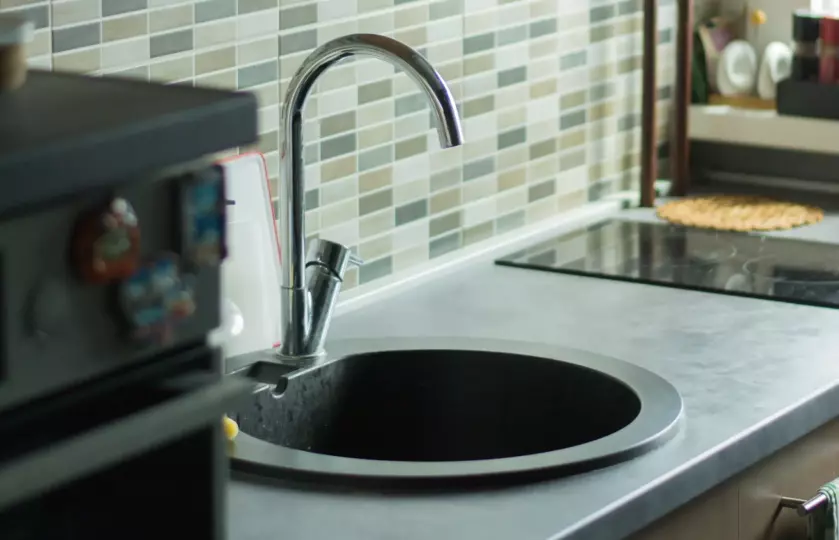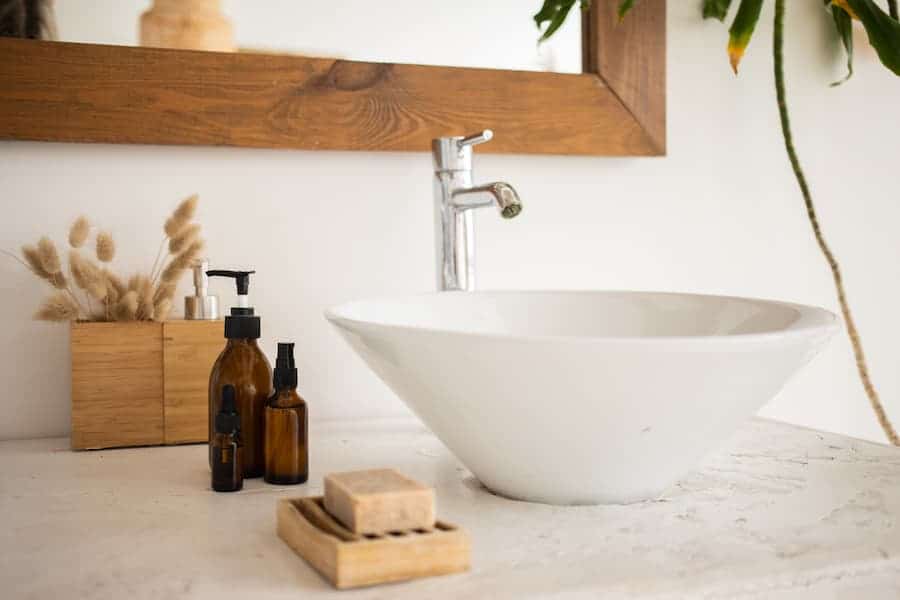If you’re looking for an effective way to clean your acrylic sink, you’ve come to the right place. Keeping your sink sparkling clean is essential to maintaining its durability and appearance. In this guide, we’ll provide you with easy-to-follow steps and tips to help you achieve a spotless acrylic sink.
Firstly, start by rinsing the sink with warm water to remove any loose debris or dirt. Then, create a cleaning solution by mixing mild dish soap with warm water. Using a soft sponge or cloth, gently scrub the sink in circular motions to remove any stains or residue.
To tackle tough stains, consider using a non-abrasive cleaner specifically designed for acrylic surfaces. Apply the cleaner onto a sponge or cloth and scrub the stained area gently. Rinse thoroughly with warm water to remove any residue.
It’s important to avoid using harsh chemicals or abrasive scrubbers on your acrylic sink, as they can cause damage and scratches. Instead, opt for non-abrasive cleaners and soft materials to protect the surface.
After cleaning, make sure to rinse the sink thoroughly to remove any soap or cleaner residue. Dry the surface with a soft towel to prevent water spots or streaks. Regular maintenance and proper cleaning will help keep your acrylic sink looking pristine for years to come.
Remember, always refer to the manufacturer’s guidelines for specific cleaning instructions for your acrylic sink. With the right approach and care,

The Best Cleaning Solutions for Acrylic Sinks
Acrylic sinks are a popular choice for many homeowners due to their durability, affordability, and sleek appearance. However, like any other type of sink, acrylic sinks can accumulate dirt, stains, and grime over time. To keep your acrylic sink looking its best, it’s important to use the right cleaning solutions. In this article, we will explore some of the best cleaning solutions for acrylic sinks that are both effective and safe to use.
1. Mild Dish Soap and Water
One of the simplest and most effective ways to clean an acrylic sink is to use mild dish soap and water. Mix a few drops of dish soap with warm water in a basin or sink. Dip a soft sponge or cloth into the soapy water and gently scrub the surface of the sink in circular motions. This method is gentle enough to remove most stains and grime without causing any damage to the acrylic material.
2. White Vinegar and Baking Soda
If you’re dealing with tougher stains or mineral deposits on your acrylic sink, a mixture of white vinegar and baking soda can work wonders. Start by sprinkling baking soda over the stained areas of the sink. Then, pour white vinegar over the baking soda and let the solution sit for a few minutes. Use a soft sponge or cloth to scrub the stained areas gently. Rinse the sink thoroughly with water and wipe it dry with a clean cloth.
3. Lemon Juice
Lemon juice is another natural cleaning solution that can effectively remove stains and leave your acrylic sink smelling fresh. Cut a lemon in half and squeeze the juice onto a soft sponge or cloth. Rub the lemon-soaked sponge onto the stained areas of the sink, applying gentle pressure. Allow the lemon juice to sit on the stains for a few minutes before rinsing the sink with water and drying it with a cloth.
4. Commercial Acrylic Cleaner
If you prefer using commercial cleaning products specifically designed for acrylic sinks, there are many options available on the market. Look for acrylic sink cleaners that are non-abrasive and specifically formulated for removing stains and grime from acrylic surfaces. Follow the instructions provided by the manufacturer for the best results.
5. Prevention Tips
While regular cleaning is essential to maintain the appearance of your acrylic sink, taking preventive measures can also help minimize the accumulation of dirt and stains. Avoid using abrasive cleaners, scrub brushes, or scouring pads, as they can scratch the surface of the sink. Additionally, be mindful of what you put in the sink to prevent staining. For example, avoid leaving coffee grounds, tea bags, or tomato sauce in the sink for extended periods.
Summary
Acrylic sinks can be easily cleaned using mild dish soap and water or a mixture of white vinegar and baking soda for tougher stains. Lemon juice is another natural option for removing stains and leaving a fresh scent. If you prefer commercial cleaners, choose ones specifically formulated for acrylic surfaces. Remember to take preventive measures to minimize staining and avoid using abrasive cleaners or tools that can scratch the surface. By using these cleaning solutions and following prevention tips, your acrylic sink will stay looking clean and beautiful for years to come.

Maintaining the Shine: Regular Care for Acrylic Sinks
Acrylic sinks are a popular choice for many homeowners due to their durability, affordability, and versatile design options. However, like any other type of sink, acrylic sinks require regular care and maintenance to keep them looking their best. In this section, we will discuss some simple yet effective ways to maintain the shine and cleanliness of your acrylic sink.
Cleaning Solutions:
When it comes to cleaning your acrylic sink, it’s important to avoid using harsh abrasive cleaners or scouring pads, as these can cause scratches and dull the finish. Instead, opt for gentle, non-abrasive cleaning solutions. A mixture of warm water and mild dish soap is usually sufficient for day-to-day cleaning. You can also use a solution of equal parts white vinegar and water to remove stains or mineral deposits.
When using any cleaning solution, it’s important to rinse thoroughly with water to remove any residue. Leaving cleaning products on the surface of your acrylic sink can lead to a dull or cloudy appearance.
Avoiding Scratches:
To prevent scratches on your acrylic sink, it’s essential to handle it with care. Avoid using sharp objects or knives directly on the surface. Instead, use a cutting board to protect the sink from any potential damage. Additionally, be mindful of what you place in the sink. Avoid dropping heavy objects or utensils that can cause impact damage.
When it comes to cleaning, opt for soft sponges or microfiber cloths instead of abrasive scouring pads. Gently wipe the surface in a circular motion to remove any dirt or grime. If you notice any stubborn stains, use a non-abrasive cleaner and a soft cloth to gently scrub the affected area.
Preventing Stains:
Acrylic sinks are prone to staining if certain substances are left on the surface for an extended period. To prevent stains, it’s crucial to clean up spills and messes promptly. Avoid leaving coffee grounds, tea bags, or other staining substances in the sink for too long. If you do notice any stains, use a mixture of baking soda and water to gently scrub the area. Rinse thoroughly and dry with a soft cloth.
Maintaining the Shine:
To maintain the shine of your acrylic sink, it’s important to dry it thoroughly after each use. Leaving standing water can cause mineral deposits and water spots to form, which can dull the surface. Use a soft cloth or towel to wipe down the sink and remove any excess moisture.
If you notice any minor scratches or dullness over time, you can restore the shine by using a non-abrasive polish specifically designed for acrylic surfaces. Apply the polish according to the manufacturer’s instructions and buff the surface gently with a soft cloth.
Conclusion:
In summary, taking care of your acrylic sink is essential to maintain its shine and longevity. By using gentle cleaning solutions, avoiding scratches, preventing stains, and drying it thoroughly after each use, you can keep your acrylic sink looking pristine for years to come. Remember, regular maintenance is key to enjoying the full benefits of your acrylic sink and keeping it in excellent condition.

Removing Stubborn Stains from Acrylic Sinks
Acrylic sinks are a popular choice in many households due to their durability and sleek appearance. However, over time, these sinks can develop stubborn stains that are not easily removed with regular cleaning methods. In this section, we will explore effective techniques to tackle these tough stains and restore the shine of your acrylic sink.
Gather the necessary supplies
Before you begin the stain removal process, it is important to gather the necessary supplies. Here are the items you will need:
- Mild dish soap
- Baking soda
- White vinegar
- Lemon
- Soft sponge or cloth
- Plastic scraper
Identify the type of stain
Before applying any cleaning solution, it is crucial to identify the type of stain you are dealing with. Common stains on acrylic sinks include hard water stains, rust stains, and food stains. This will help you choose the most effective cleaning method.
Remove hard water stains
To remove hard water stains, start by mixing equal parts white vinegar and water in a spray bottle. Spray the solution onto the stained areas and let it sit for a few minutes. Then, scrub the stains gently with a soft sponge or cloth. Rinse the sink thoroughly with water and dry it with a clean cloth.
Eradicate rust stains
Rust stains can be more challenging to remove. Begin by creating a paste with baking soda and water. Apply the paste directly to the stained areas and let it sit for about 15 minutes. Then, scrub the stains using a soft sponge or cloth. If the stains persist, you can try using a plastic scraper to gently scrape off the remaining rust. Rinse the sink well and dry it thoroughly.
Tackle food stains
Food stains can be stubborn, especially if they have been left to sit for a long time. Start by squeezing fresh lemon juice onto the stained areas. Let the lemon juice sit for a few minutes to break down the stains. Then, scrub the stains gently with a soft sponge or cloth. Rinse the sink thoroughly and dry it with a clean cloth.
Prevent future stains
Once you have successfully removed the stubborn stains from your acrylic sink, it is important to maintain its cleanliness to prevent future stains. Here are a few tips:
- Regularly clean your sink using mild dish soap and warm water.
- Avoid using abrasive sponges or cleaners that can scratch the surface of the sink.
- Wipe away any spills or stains immediately to prevent them from setting.
- Consider using a protective mat or tray at the bottom of your sink to prevent scratches and stains.
Summary
Acrylic sinks can develop stubborn stains over time, but with the right techniques, you can easily remove them and restore the shine of your sink. By identifying the type of stain and using the appropriate cleaning method, you can tackle hard water stains, rust stains, and food stains effectively. Remember to prevent future stains by maintaining regular cleaning habits and taking precautions to protect your sink.
Avoiding Scratches: Gentle Cleaning Methods for Acrylic Sinks
Acrylic sinks are a popular choice for many homeowners due to their durability and aesthetically pleasing appearance. However, they can be prone to scratches if not properly cared for. In this section, we will discuss some gentle cleaning methods that can help you maintain the beauty of your acrylic sink while avoiding scratches.
1. Use Soft Non-Abrasive Cleaners
When cleaning your acrylic sink, it is important to use gentle, non-abrasive cleaners. Avoid using abrasive scrubbers or harsh chemicals as they can cause scratches on the surface of the sink. Instead, opt for mild dish soap or a specially formulated acrylic sink cleaner. Apply the cleaner with a soft sponge or cloth, gently scrubbing the surface in a circular motion.
2. Avoid Scrubbing with Rough Materials
It’s essential to avoid using rough materials such as steel wool or scouring pads when cleaning your acrylic sink. These materials can easily scratch the surface, leaving behind unsightly marks. Instead, use a soft-bristled brush or sponge to gently clean the sink. Remember to rinse thoroughly after cleaning to remove any residue.
3. Be Mindful of Stains
Acrylic sinks are prone to staining, especially if left untreated for an extended period. To prevent stains, it is important to clean up spills and stains as soon as they occur. Use a mild detergent or baking soda paste to gently scrub away any stains. Avoid using bleach or abrasive cleaners, as they can cause discoloration.
4. Regular Maintenance
Regular maintenance is key to keeping your acrylic sink scratch-free. After each use, rinse the sink with warm water and mild soap to remove any dirt or debris. Dry the sink thoroughly with a soft cloth to prevent water spots or mineral buildup. It is also recommended to apply a non-abrasive acrylic sink polish every few weeks to restore the sink’s shine and protect it from scratches.
5. Handle with Care
Lastly, it is important to handle your acrylic sink with care to avoid accidental scratches. Avoid placing sharp or heavy objects directly on the sink’s surface to prevent scratches. Use cutting boards or trivets to protect the sink when working with utensils or hot pots and pans. Also, be mindful of the temperature of the water you use, as extreme hot or cold water can damage the sink.
Summary
Maintaining the beauty of your acrylic sink while avoiding scratches is possible with gentle cleaning methods. Use soft non-abrasive cleaners, avoid scrubbing with rough materials, be mindful of stains, perform regular maintenance, and handle the sink with care. By following these tips, you can keep your acrylic sink looking pristine for years to come.
FAQs
1. How do I clean an acrylic sink?
To clean an acrylic sink, start by rinsing it with warm water to remove any loose debris. Then, mix a solution of mild dish soap and warm water. Dip a soft cloth or sponge into the soapy water and gently scrub the sink in a circular motion. Rinse the sink thoroughly with warm water and dry it with a soft towel to prevent water spots.
Conclusion:
In conclusion, keeping your acrylic sink clean and well-maintained is essential for its durability and longevity. By following a few simple steps, you can easily clean your acrylic sink and keep it looking brand new.
Remember to use non-abrasive cleaners and avoid harsh chemicals that can damage the surface. Regularly clean and rinse the sink after each use to prevent stains and buildup. For tough stains, a mixture of baking soda and water can be used as a gentle scrub.
Additionally, avoid using sharp objects or abrasive materials that can scratch the surface of your sink. By incorporating these cleaning tips into your routine, you can enjoy a sparkling and pristine acrylic sink for years to come.
